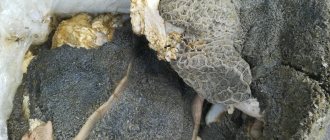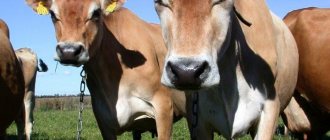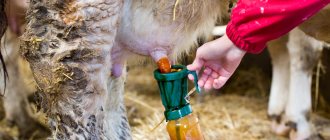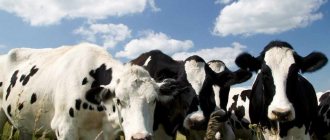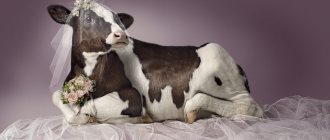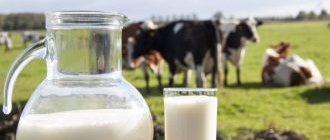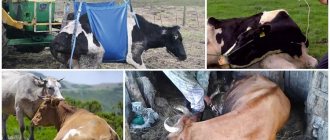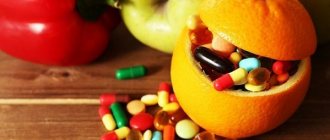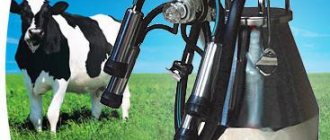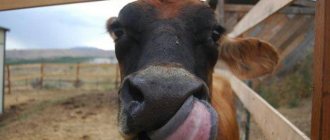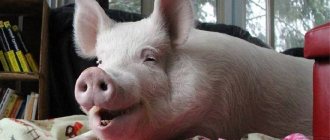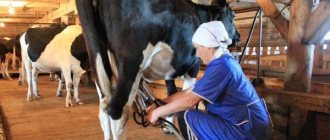In this article we will tell you why a cow lame. Cattle (cattle) are at risk of musculoskeletal diseases. Due to covering huge distances on pastures, cows' legs experience enormous stress. As a result, if the animal is not properly cared for, you may notice a slight lameness. Even a minor defect in your Zorka's steps can affect her health, behavior and milk production. You will learn how to avoid such diseases from our article.
How to determine the presence of lameness
The most effective, and at the same time ancient, method for determining lameness in cows is to observe their movement. In general, lameness in a cow is divided into several stages depending on the complexity of the disease. So, deviations from the norm, the degree and severity of the disease can be identified by certain signs.
A mild degree is when the animal has a slight limp. He keeps his back straight only while standing still. While walking, he takes shorter steps, while his back is bent. Does not place emphasis on any limb.
Moderate lameness is considered if the cow stands and walks with an arched back. Takes short steps. Tries to minimize the load on the leg. When shifting body weight onto the painful area, the head may tilt down.
If the lameness is severe, then the cow's movements become constrained and indecisive. She stands and moves with an arched back. Trying not to put stress on the injured leg. Stops often. Possible weight loss and increased salivation.
In extreme lameness, the cow's back is permanently arched. She is unable to move and does not put any strain on her leg at all.
What does foot health depend on?
The health of the hoof horn depends on its water content, which it absorbs from the external environment and partially releases. It is known that normal claw horn contains up to 40% moisture. If the relationship between moisture absorption and its release is disrupted, the horn becomes fragile, creases and cracks occur. When softened in damp weather or when animals are kept in damp conditions, the horn deforms more quickly under the weight of the body.
Keeping cows on deep, permanent bedding results in the animals' limbs being exposed to conditions of high humidity and high temperature. Even in winter, at an external temperature of minus 4-8°C, the temperature of the purulent cushion at a depth of 5-4 cm reaches 30-34°C. under such conditions, the hoof horn grows quickly, absorbs water, becomes more elastic, and is not worn enough. Therefore, the horny capsule lengthens and bends, as a result of which the body weight is distributed unevenly on the hooves.
Keeping them in short stalls also leads to the development of deformities. In this case, body weight is unevenly distributed over the entire area of the sole, increasing in some places to 5-7 kg/cm2 with a norm of 3-4 kg. This leads to infringement of the base of the skin, hemorrhage, and the development of chronic diseases that manifest themselves as lameness.
Most common diseases
The number of diseases for which lameness is a harbinger is very large. Their symptoms are also varied. But the most common diseases that lameness can cause are: bursitis, dermatitis, arthrosis, arthritis, laminitis, erosions and ulcers that occur on the sole of the hooves. Common dislocations, sprains of ligaments and joints are common. Various inflammations and bone displacements cannot be ruled out as a result of the careless actions of your cow.
But whatever the reason, you cannot make a diagnosis and treat the animal on your own; you need to contact a professional - a veterinarian. It should not be forgotten that similar problems can be dangerous for calves. The likelihood of dislocations and sprains is especially high due to the violent teenage temperament of the calf.
If a cow sprains her leg
Tendon stretching is a closed mechanical damage to it, accompanied by rupture of tendon fibrils and the vessels that feed them while maintaining the anatomical continuity of the tendon. Tendon rupture is a complete disruption of its anatomical continuity, accompanied by loss of function of the corresponding muscle. Causes. Excessive tension in the tendons during fast running, overstraining them during jumping, when stumbling, or when carrying heavy weights; various impacts can also cause tendon rupture. Stretching and rupture of the flexor tendons often occur in bulls and cows when their hooves are not trimmed in a timely manner. Tendon ruptures are predisposed by diseases that reduce their resistance to physical stress (rickets, osteomalacia, etc.). Pathogenesis. The mechanism of injury when stretching and rupturing tendons is caused by excessive tension of their tissues by two forces acting in opposite directions, or strong traction in one direction with the opposite end of the tendon (muscle) fixed. When stretched, individual fibrils and small blood vessels rupture and minor hemorrhages occur in the interfibrillar tissue. Tendon ruptures can be partial (tears) or complete. With the former, the integrity of a significant number of tendon bundles is disrupted, usually on one surface of the tendon, and with the latter, complete ruptures of the entire tendon occur. The defect in the tendon is first filled with blood, then fibrin, and then replaced by connective tissue. Clinical signs. Stretching and partial ruptures of the tendons are accompanied by signs of aseptic tendonitis. They are characterized by severe lameness and severe pain in the affected area. With aseptic tendinitis, these signs are less pronounced than with sprains and partial ruptures of the tendons. When a complete rupture occurs, the tendon relaxes, and a defect (gap) forms at the site of its damage. Tendon rupture is most often observed at the point of its attachment to the bone or at the junction of muscle and tendon. The function of the limb when the tendon is damaged is impaired suddenly, following the injury. Passive movements of the joints establish their abnormal mobility. When the animal tries to lean on the affected limb, the non-fixed joints sharply change their position. Particular symptoms of ruptures of individual tendons depend on which muscle the damaged tendon belongs to, as well as on the nature of the rupture (partial or complete) and its location. When the tendon of the third interosseous muscle is completely ruptured, the fetlock joint at the moment of support of the limb is excessively extended, while the brush almost touches the ground, while the hoof rests normally. When this tendon ruptures in cattle, the support occurs on the heel parts of the hooves, and their toe parts are raised upward. With incomplete ruptures of the interosseous muscle tendon in animals, the same symptoms are observed as with a complete rupture, but they are less pronounced. With a complete rupture of the tendon of the superficial flexor of the digit, the animal at rest spares the affected limb, the support occurs on the heel parts of the hoof, and its toe part is raised slightly upward. With a complete rupture of the deep digital flexor tendon, the animal rests on the heel part of the hoof, and its toe part is strongly raised upward. The coronoid and fetlock bones occupy an almost horizontal position, and there is a strong bending of the limb at the fetlock joint. When the common or long extensor finger is torn, the forward movement of the limb is accompanied by insufficient extension of the finger joints, as a result of which the toe part of the hoof sometimes drags on the ground. At rest, the dysfunction of the affected limb is almost invisible. Forecast. Depends on the location and nature of the damage, as well as on the type of animal. In large animals, complete ruptures of tendons such as the Achilles, deep flexor digitorum, and both legs of the interosseous muscle are not curable, and in cases of recovery, permanent lameness remains. Tendon sprains and partial ruptures are usually healed in both small and large animals. Treatment. The animal is given rest. For sprains and incomplete ruptures of tendons, cold is applied to the area of injury in the first hours, and heat is subsequently applied. The affected limb is immobilized with a splint or plaster cast for 6-8 weeks. In case of complete tendon ruptures in small and sometimes large animals, the ends of the tendon are brought together with tendon sutures, after which an immobilizing bandage is applied.
Source
Bedding and foot baths will help
If the cow is lame, the treatment itself and the terms of rehabilitation are prescribed by a veterinarian. But prevention and care for your pet is entirely the responsibility of the owner.
Proper care of the cow now means health and good milk yield in the future.
During treatment, it is necessary to create conditions that prevent the disease from worsening. For example, infectious diseases can be easily combated by using dry bedding under your cow's hooves and foot baths to keep her feet clean. Rest and proper feeding, filled with vitamins and microelements, will also contribute to a speedy recovery. Maintain moisture balance in the hooves, especially the hindquarters. And never ignore any deviations in cow behavior.
Preventive actions
The best way to prevent disease is prevention. In our case, preventive actions will be:
- timely change of litter;
- normal level of hoof moisture;
- the presence of a flat, comfortable and not too hard floor surface (rubber mats are ideal in this sense);
- To reduce the likelihood of getting bursitis (inflammation in the joint area), use food filled with various micro- and macroelements.
- make hoof baths (for example, a solution of 10% zinc sulfate once every 7-10 days, a 5% solution of formaldehyde can help);
- provide a spacious pen.
But what to do if the cow is already limping on her front leg? First of all, inspect the hoof, perhaps something has got there. If the joint on the leg is swollen, then this is another reason, and the cow should be shown to a veterinarian. To alleviate the animal's condition in case of injury, bandage the leg, apply ichthyol ointment and give an injection of traumatine.
Preventive measures
In order to prevent diseases of the cow's hooves, they are cut down if they become excessively elongated.
Before the hoof trimming procedure, the cow should be laid down and immobilized. This has an impact on the quality of work. First you need to trim the front hooves. The area of the bottom layer of the hoof should be perpendicular to the axis of the leg so that when walking the cow rests on the entire hoof.
First you need to trim the front hooves.
Along with shortening, you should examine the entire leg for wounds and lesions. If wounds and abrasions are found, you should immediately treat them with iodine.
The popular method of pruning is cutting with a grinder.
After the hoof cutting procedure, they need to be disinfected with a solution of formaldehyde or copper sulfate (baths should be arranged).
Let's say a word about the hooves
Another important element of prevention will be monitoring the condition, shape and cleanliness of the hooves. This tough part of the cow's body consists of living tissue, which contains capillaries and blood vessels. Therefore, hooves tend to become deformed. As a result, many diseases appear that affect the musculoskeletal system.
To avoid such consequences, the cow's hooves should be trimmed or filed. But this must be done carefully, as it can cause harm to the animal. In addition, it is worth cleaning the walls between the hooves.
If the foot is not supported properly, bunions can come to the surface. In particular, it occurs around the joint on the wrist, and the skin may become keratinized. At the initial stages, these formations do not pose a big threat. But if this process is started, then the cow can be safely sent to slaughter.
Bursitis, accompanied by inflammation, most often occurs as a result of mechanical stress on the cow's limbs. But it happens that infections become the cause. For example, if the stall does not comply with sanitary standards.
Why does a cow pull her leg and limp?
Most often, a cow begins to limp or drag her leg due to various joint diseases, deformation of the stratum corneum and infections in the hoof area. The most common foot diseases in cattle include:
- bursitis;
- erosion;
- arthrosis;
- dermatitis;
- arthritis;
- laminitis
Important!
Only a veterinarian can make an accurate diagnosis, because many diseases of cows’ legs have similar symptoms: swelling, pain, ulcers and cracks, purulent discharge, etc. If the stratum corneum on cows’ legs is simply deformed, simple trimming will improve the situation, however, very often, various complications in the form of suppuration and swelling are added to the growths. In this case, the help of a veterinarian is required, who must prescribe subsequent treatment. As first aid after trimming the stratum corneum, you can treat the cut site on the cattle’s legs with an antiseptic so as not to aggravate the situation with any infection.
Cows can also lame due to a dislocation or sprain - this is one of the simplest options. Sometimes animals do not even require treatment; they quickly recover without outside help. It is much more problematic if the cow’s leg bones have been displaced by a blow or other mechanical impact. If a cow's legs fail as a result of such injuries, there is no point in starting treatment - the animal is sent for slaughter.
You can determine whether a cow is limping by the following signs:
- the animal moves extremely carefully and constrainedly;
- it is difficult for him to get up from his seat;
- lethargy, apathy, and refusal to feed are observed;
- the cow may change position frequently to relieve leg pain;
- sometimes due to improper weight distribution the cow leans forward too much.
Additionally, it is noted that a sick cow’s milk yield is noticeably reduced – from 30% and above. The cause is loss of appetite, which can lead to complete refusal of food.
Reasons if a cow's leg is swollen above the hoof
Most often, swelling of the legs of cows in the area just above the hooves indicates phlegmon, a disease that is expressed in inflammation of the corolla of the stratum corneum. It affects the fiber located under the skin. The disease is usually caused by some kind of infection. Contusion of the inflamed area can complicate the situation.
Additionally, phlegmon on the legs of cows is determined by the following signs:
- weakness of the animal;
- the hoof wall begins to sag;
- the intercoffin surface swells noticeably.
Bursitis is very dangerous for cows. If the animal not only limps and drags its leg, but also has a noticeable swelling in the joint area of the wrist, this may be the beginning of the process of keratinization of this area. In the first stages of bursitis development, the animal can still be helped, however, the advanced disease cannot be treated.
Important! The risk of developing bursitis is increased by foot injuries and various infections that appear as a result of unsanitary conditions in stalls.
Reasons if a cow's leg hurts, where is the hoof?
In order to recognize a developing disease in time, at the first signs of lameness in a cow, the legs, especially the hoof area, are examined. Preventive inspections are mandatory in winter, when the herd moves little and the risk that the animals will begin to limp increases significantly. Due to the lack of movement, the stratum corneum on the legs of cows stops grinding down and, as a result, grows to a significant size so that the edge even begins to bend upward.
In addition, problems can also occur in the soft areas of the hoof, such as the small lobe underneath and just behind the stratum corneum. This area is easily damaged during grazing, after which the wound can become infected. Ultimately, the animal begins to limp, and when examining the legs and pressing on the damaged area, pain occurs.
Important! Small calves especially often suffer from mechanical damage, in which the stratum corneum is still very thin, and the soft tissues are much more delicate than in adult animals.
In most cases, pain in the hoof area occurs as a result of the development of fusobacteriosis (necrobacteriosis). The cow begins to limp and fall on her leg due to the fact that a large crack appears in the heel area where the soft tissues are located. The area around the damage quickly swells and becomes inflamed, after which the infection spreads to the horny shoe area and penetrates deeper.
Cattle also often suffer from leg erosion, when the hooves are formed incorrectly and loads are redistributed. The pressure is stronger on the outside than on the inside. As a result, the internal soft tissues of the hoof are damaged, the process of rotting begins, and the animal becomes lame on its leg.
Advice! You can help the animal using a special heel, which is attached to a healthy area of the stratum corneum. Thus, the weight of the sick individual will be automatically transferred to this heel, and the diseased area will rise. The pain should gradually subside.
